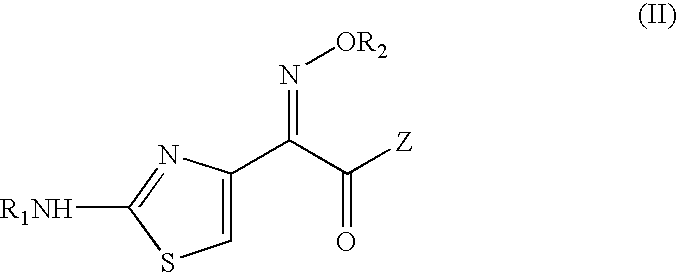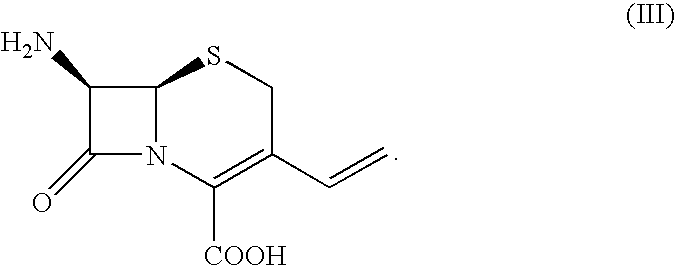Intermediate cefdinir salts
- Summary
- Abstract
- Description
- Claims
- Application Information
AI Technical Summary
Benefits of technology
Problems solved by technology
Method used
Image
Examples
example 1
Preparation of 7-[2-(aminothiazol-4-yl)-2-(trityloxyimino)-acetamido]-3-vinyl-3-cephem-4-carboxylic acid dicyclohexylamine salt
[0036] 1,1,3,3-Tetramethylguanidine (35.8 ml) is added in 15 min to a suspension of 7-amino-3-vinyl-3-cephem-4-carboxylic acid (65.0 g) in N,N-dimethylformamide (0.78 L) previously cooled to 10° C. and the mixture is stirred at this temperature until complete dissolution. 2-(Aminothiazol-4-yl)-2-(trityloxyimino)acetic acid S-mercaptobenzothiazolic ester (172.7 g) is added thereto in 15 min and the mixture is stirred at this temperature until complete conversion of 7-amino-3-vinyl-3-cephem-4-carboxylic acid (HPLC analysis). After completion of the reaction, water (1.7 L) and ethyl acetate (2.2 L) are added and the pH is adjusted to 3.0 with diluted hydrochloric acid. The phases are separated and the organic one is washed with a 20% sodium chloride solution in water (0.86 L). The phases are separated and dicyclohexylamine (54.1 ml) is added in 30 min to the o...
example 2
Preparation of 7-[2-(aminothiazol-4-yl)-2-(trityloxyimino)-acetamido]-3-vinyl-3-cephem-4-carboxylic acid dicyclohexylamine salt
[0038] Triethylamine (9.1 ml) is added in 20 min to a suspension of 7-amino-3-vinyl-3-cephem-4-carboxylic acid (7.5 g) in N,N-dimethylformamide (90 ml) previously cooled to 15° C. 2-(Aminothiazol-4-yl)-2-(trityloxyimino)acetic acid S-mercaptobenzothiazolic ester (19.7 g) is added thereto in 15 min and the mixture is stirred at this temperature until complete conversion of 7-amino-3-vinyl-3-cephem-4-carboxylic acid (HPLC analysis). After completion of the reaction water (200 ml) and ethyl acetate (250 ml) are added and the pH is adjusted to 3.0 with diluted hydrochloric acid. The phases are separated and the organic one is washed with a 20% sodium chloride solution in water (200 ml). The phases are separated and dicyclohexylamine (7.2 ml) is added to the organic one in 15 min. Formation of crystals is observed. After further 15 min the mixture is cooled to 0...
example 3
Preparation of 7-[2-(aminothiazol-4-yl)-2-(trityloxyimino)-acetamido]-3-vinyl -3-cephem-4-carboxylic acid dicyclohexylamine salt
[0039] N,O-bistrimethylsilylacetamide (8.0 ml) is added in 15 min to a suspension of 7-amino-3-vinyl-3-cephem-4-carboxylic acid (7.5 g) in N,N-dimethylacetamide (50 ml) at 25° C. After further 20 min, 2-(aminothiazol-4-yl)-2-(trityloxyimino)acetic acid S-mercaptobenzothiazolic ester (19.8 g) is added and the mixture is stirred at this temperature until complete conversion of 7-amino-3-vinyl-3-cephem-4-carboxylic acid (HPLC analysis). After completion of the reaction, ethyl acetate (250 ml) and methanol (3 ml) are added and the mixture is stirred for 15 minutes. Water is then added (200 ml) and stirring is continued for further 15 min.
[0040] The phases are separated and the organic one is washed with a 20% sodium chloride solution in water (200 ml). The phases are separated and dicyclohexylamine (7.2 ml) is added to the organic phase in 15 min. Formation o...
PUM
 Login to View More
Login to View More Abstract
Description
Claims
Application Information
 Login to View More
Login to View More - R&D
- Intellectual Property
- Life Sciences
- Materials
- Tech Scout
- Unparalleled Data Quality
- Higher Quality Content
- 60% Fewer Hallucinations
Browse by: Latest US Patents, China's latest patents, Technical Efficacy Thesaurus, Application Domain, Technology Topic, Popular Technical Reports.
© 2025 PatSnap. All rights reserved.Legal|Privacy policy|Modern Slavery Act Transparency Statement|Sitemap|About US| Contact US: help@patsnap.com



